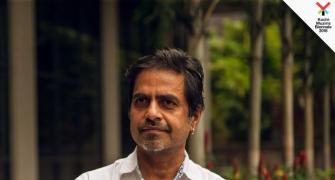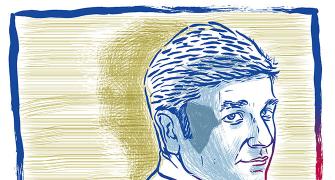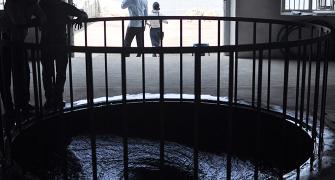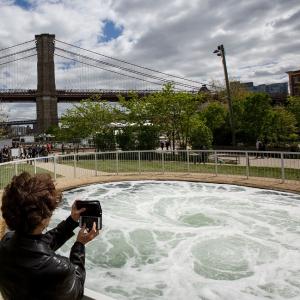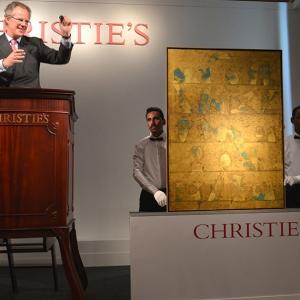Dayanita Singh, artist and curator, gives photography a new art form, discovers Avantika Bhuyan.
As one enters Dayanita Singh's home in Vasant Vihar, New Delhi, two empty wooden structures, situated in the living room, catch the eye.
Covered in cloth, they look enshrouded, waiting to reveal their mysteries at an opportune time.
This visual unlocks other memories, taking one back to 2015 when similar wooden structures stood in a labyrinthine maze at the Kiran Nadar Museum of Art, New Delhi.
Museum Bhavan, Singh had called this collection of memories, born out of years of ruthless editing, sequencing and archiving of images, which she had scattered across nine wooden structures.
Each structure had a name: Museums of Little Ladies, Vitrines, Furniture, Men, Chance, Machines, and more.
Like a magician, Singh would take out boxes from a museum, mount them on walls, empty certain frames, add new images, shut a structure down completely, while another rose in its stead, thus playing the dual role of an artist and a curator.
The viewer was free to create unique permutations and combinations by choosing the direction to take within the Bhavan: Move from the File Museum on to the Museum of Little Ladies, or take a left to the Museum of Men.
Each turn enabled you to make your own links between the structure that you had moved on to and the one you had left behind.
These novel mobile museums were not just significant in pioneering the concept of 'photo architecture', but also for bringing out a drastic shift in the way we viewed photography.
"To me, the Museum Bhavan held interest for its portable architectural form," says Roobina Karode, director, Kiran Nadar Museum of Art, Delhi.
"It seemed as if the wooden structures had extended limbs, which could transform into shelves, cabinets, doors and quiet corners. One doesn't get this experience by seeing photographs on a wall, which offers a frontal and straightforward encounter."
It is to acknowledge this shift in the viewer's engagement with photography and Singh's role in bringing about this transformation that the Museum of Modern Art, New York, acquired her Museum of Chance.
Comprising two wooden structures, 162 images, four tables, four stools and 26 smaller boxes to be displayed on the wall, the museum contains photos from the start of her career till now.
Singh had always been clear that she would never part with the Museum of Chance, unless it was MoMA, as she had remarked to Jane Hamlyn, founder and director of the Frith Street Gallery.
"This museum holds some intrinsic part of me... seeds of my creative process. So, when Jane asked me if I was absolutely sure that I wouldn't reconsider my decision, I said, well, only if it's MoMA," she says.
Singh feels it's an ultimate honour for an artist to be part of a museum collection, to know that your work will be looked after and shown periodically.
For instance, the Tate Modern has all 40 of the silver prints that formed part of Go Away Closer, which it will be showing again this summer.
"But for MoMA to have acquired the Museum of Chance means that they have acquired the concept. Clearly, they have understood the idea and see the need to make shifts in the way we view photography," she says.
It was while she was installing the Museum Bhavan at the KNMA that a group from MoMA had come by.
The team saw curator Shanay Jhaveri create Museum of Erotics from the Museum of Chance and Aneeth Arora create the Museum of Cloth.
"And when the Museum Bhavan was shown at the Bhau Daji Lad Museum in Mumbai, I recorded a video of myself from the top, opening and closing the Museum of Chance," she says.
So, MoMA doesn't just get the Museum of Chance, but also the documentation of the many lives that it has lived, and the many mini museums it has given birth to.
"Even now there are three to four museums incubating within it. I have already made a document with suggestions on the various combinations. The curators might have different suggestions that they might want to work on," she says.
Just like her past work, the Museum of Chance too has embarked on its own journey, for other people to spin their personal narratives with the story that Singh set out to tell.

Photograph: Kind courtesy @dayanita.singh/Facebook
The one question that Singh has been raising time and again is that of the museum as a form in itself.
In December last year, she travelled with a set of 44 book objects in two suitcases, with an A4-size catalogue inside, which became the Suitcase Museum and was shown at the Bhau Daji Lad Museum.
"To me, the museum of the future is small and portable. It's organic and allows for change and growth continuously," she had said on the occasion.
It is for this reason that in the past couple of years, starting with Sent a Letter (2008), that the photo book has emerged as Singh's primary medium.
'Her most recent endeavors, which she calls "book-objects", simultaneously comprise a book, an object for display, an exhibition and a catalog of that exhibition,' writes Jordan G Teicher in The New York Times.
Singh has, for some time, been talking about bridging the gap between publishing and the gallery space.
"So, I thought why not do this myself?" she says.
And so, she launched Spontaneous Books, recently, which allows her to build limited-edition books.
The first such offering from this imprint is the Kochi Box, showcased at the Kochi Biennale. It came in an edition of 360 and contained 30 images that she made in Kerala.
A couple of months later, as we converse yet again over pomegranate papaya and almond smoothies, she says that 330 people now have the Kochi Box at home.
"The very act of going to the wall and saying I want to take this home makes us view things differently than if you were to mail order," she says.
It also invests the viewer with the exciting role of a curator.
If you have three boxes, you have more than 90 configurations to play around with.
You can change the image in front daily, weekly or once a month.
"In each home, there will be at least five to six people engaging with it. Say, your daughter might ask you to tell the story of each picture every day. If a friend is coming over, you might put a particular picture in the front. The Kochi Box allows you to re-edit, re-arrange and re-curate," she says.
Singh is now working on a box loosely based on buildings designed by Geoffrey Bawa, who is considered one of the most influential Asian architects of all times.
"It includes images from other architecture too, including Padmanabhapuram," she says.
The Museum Bhavan too has found itself a new avatar "in miniature as a book published in April by Steidl.
Here, the museums live in nine accordion-fold booklets housed in a unique box handmade in India.
'Singh wants readers to arrange the booklets however they wish, designing their own exhibition,' writes Teicher about the Pocket Museum.
In a bid to make her work accessible to all, Singh wants to work in larger editions that are affordably priced: The Kochi Box is available for ₹9,000 and the Pocket Museum for ₹5,500.
In some ways, her work holds out hope for aspiring young professionals, who are looking at starting their collecting journeys, but are often deterred by the high prices of artworks.
- On Rediff Books: Dayanita Singh's File Room


